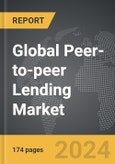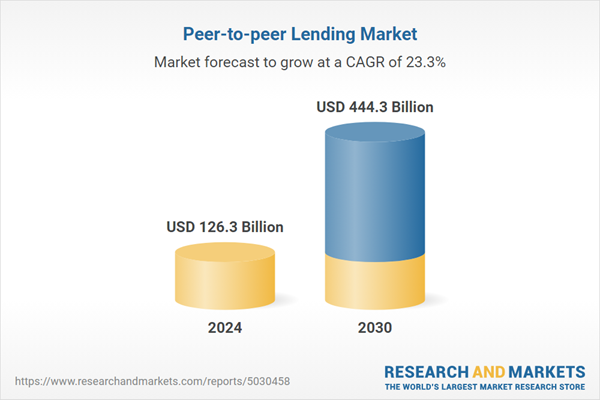The global market for Peer-to-peer Lending was valued at US$126.3 Billion in 2024 and is projected to reach US$444.3 Billion by 2030, growing at a CAGR of 23.3% from 2024 to 2030. This comprehensive report provides an in-depth analysis of market trends, drivers, and forecasts, helping you make informed business decisions. The report includes the most recent global tariff developments and how they impact the Peer-to-peer Lending market.
Segments: Business Model (Traditional P2P Model, Marketplace Lending Model); End-Use (Small Business, Consumer Credit, Real Estate, Student Loan, Other End-Uses).
Geographic Regions/Countries: World; United States; Canada; Japan; China; Europe (France; Germany; Italy; United Kingdom; Spain; Russia; and Rest of Europe); Asia-Pacific (Australia; India; South Korea; and Rest of Asia-Pacific); Latin America (Argentina; Brazil; Mexico; and Rest of Latin America); Middle East (Iran; Israel; Saudi Arabia; United Arab Emirates; and Rest of Middle East); and Africa.
The analysts continuously track trade developments worldwide, drawing insights from leading global economists and over 200 industry and policy institutions, including think tanks, trade organizations, and national economic advisory bodies. This intelligence is integrated into forecasting models to provide timely, data-driven analysis of emerging risks and opportunities.
Global Peer-to-Peer Lending Market - Key Trends & Drivers Summarized
How Has Technology Transformed the Peer-to-Peer Lending Landscape?
The peer-to-peer (P2P) lending market has undergone a dramatic transformation, largely driven by advancements in financial technology (fintech). P2P lending platforms have emerged as an innovative alternative to traditional banking systems, allowing individuals to borrow money directly from other individuals or institutional investors via online platforms. The advent of fintech has simplified this process, enabling automated credit assessments, algorithm-driven matchmaking between lenders and borrowers, and digital transaction management, all of which are reducing operational costs and improving transparency. Blockchain technology is also being introduced to further enhance the security of P2P transactions, offering a decentralized and immutable ledger for recording transactions, thereby reducing fraud risks. Additionally, artificial intelligence (AI) and machine learning (ML) tools are being used to assess credit risk more accurately by analyzing vast amounts of data, including alternative data points that go beyond traditional credit scores. These technological advancements are making P2P lending more accessible, scalable, and reliable, creating new opportunities for both lenders and borrowers.Why Is P2P Lending Gaining Popularity Among Borrowers and Investors?
The growing popularity of peer-to-peer lending can be attributed to the significant benefits it offers to both borrowers and lenders, particularly in comparison to traditional banking methods. Borrowers, especially those who may not qualify for loans from conventional financial institutions due to strict credit score requirements or lack of collateral, find P2P platforms to be a more accessible and flexible option. These platforms often offer lower interest rates and faster approval times, making them attractive to borrowers seeking personal loans, debt consolidation, or small business financing. On the other side, individual and institutional investors are drawn to P2P lending as a means of diversifying their investment portfolios. With interest rates in traditional savings accounts remaining low, P2P lending offers the potential for higher returns, albeit with a corresponding increase in risk. Investors can also diversify their risk by spreading their investments across multiple borrowers, thereby minimizing the impact of potential defaults. As more individuals and institutions seek alternatives to traditional banking and investment products, the appeal of P2P lending continues to grow, driving significant expansion in the market.How Are Changing Consumer Preferences Shaping the P2P Lending Market?
Consumer preferences are playing a crucial role in shaping the evolution of the P2P lending market. In today’s digital-first world, consumers expect convenience, speed, and transparency when it comes to financial services. P2P lending platforms meet these expectations by providing a seamless user experience through intuitive online interfaces and mobile apps. The ability to apply for loans, track progress, and manage investments from a smartphone or computer is particularly appealing to tech-savvy millennials and Gen Z borrowers, who are accustomed to digital banking and expect similar ease from lending services. Moreover, the growing distrust in traditional banking institutions, fueled by the global financial crisis and subsequent banking scandals, has led many consumers to seek alternative financial solutions like P2P lending. As a result, these platforms are building trust by offering greater transparency in terms of fees, interest rates, and lending practices, which contrasts with the often opaque processes of traditional banks. Additionally, the rise of financial inclusion, particularly in developing markets, is driving the adoption of P2P lending as a way to provide financing to underserved populations who may not have access to traditional credit.What Factors Are Driving Growth in the Peer-to-Peer Lending Market?
The growth in the peer-to-peer lending market is driven by several factors, including technological innovations, evolving consumer behaviors, and regulatory changes. The increasing digitization of financial services and the rise of fintech have made it easier for P2P platforms to scale rapidly, offering streamlined loan processing, risk assessment, and digital payments, all of which are key drivers for the market. In addition, shifting consumer preferences towards faster, more transparent, and flexible financial solutions are propelling the demand for P2P lending, particularly among millennials and younger borrowers who prioritize convenience and lower interest rates. The global push for financial inclusion, especially in emerging markets, is also fueling growth as P2P platforms bridge the gap between unbanked or underbanked individuals and access to credit. Furthermore, institutional investors are increasingly entering the P2P space, attracted by the higher returns compared to traditional investment vehicles. Regulatory developments in key markets, including more defined frameworks for operating P2P lending platforms, are providing legitimacy and encouraging more widespread adoption. These factors combined are driving robust growth in the P2P lending market, as it continues to disrupt traditional lending models and expand into new geographic and demographic segments.Report Scope
The report analyzes the Peer-to-peer Lending market, presented in terms of units. The analysis covers the key segments and geographic regions outlined below.Segments: Business Model (Traditional P2P Model, Marketplace Lending Model); End-Use (Small Business, Consumer Credit, Real Estate, Student Loan, Other End-Uses).
Geographic Regions/Countries: World; United States; Canada; Japan; China; Europe (France; Germany; Italy; United Kingdom; Spain; Russia; and Rest of Europe); Asia-Pacific (Australia; India; South Korea; and Rest of Asia-Pacific); Latin America (Argentina; Brazil; Mexico; and Rest of Latin America); Middle East (Iran; Israel; Saudi Arabia; United Arab Emirates; and Rest of Middle East); and Africa.
Key Insights:
- Market Growth: Understand the significant growth trajectory of the Traditional P2P Model segment, which is expected to reach US$168.2 Billion by 2030 with a CAGR of a 16.8%. The Marketplace Lending Model segment is also set to grow at 28.9% CAGR over the analysis period.
- Regional Analysis: Gain insights into the U.S. market, valued at $32.7 Billion in 2024, and China, forecasted to grow at an impressive 30.9% CAGR to reach $125.0 Billion by 2030. Discover growth trends in other key regions, including Japan, Canada, Germany, and the Asia-Pacific.
Why You Should Buy This Report:
- Detailed Market Analysis: Access a thorough analysis of the Global Peer-to-peer Lending Market, covering all major geographic regions and market segments.
- Competitive Insights: Get an overview of the competitive landscape, including the market presence of major players across different geographies.
- Future Trends and Drivers: Understand the key trends and drivers shaping the future of the Global Peer-to-peer Lending Market.
- Actionable Insights: Benefit from actionable insights that can help you identify new revenue opportunities and make strategic business decisions.
Key Questions Answered:
- How is the Global Peer-to-peer Lending Market expected to evolve by 2030?
- What are the main drivers and restraints affecting the market?
- Which market segments will grow the most over the forecast period?
- How will market shares for different regions and segments change by 2030?
- Who are the leading players in the market, and what are their prospects?
Report Features:
- Comprehensive Market Data: Independent analysis of annual sales and market forecasts in US$ Million from 2024 to 2030.
- In-Depth Regional Analysis: Detailed insights into key markets, including the U.S., China, Japan, Canada, Europe, Asia-Pacific, Latin America, Middle East, and Africa.
- Company Profiles: Coverage of players such as (AFPI) Asosiasi FinTech Pendanaan Bersama Indonesia, Afroteller, Any Time Loan, Assetz Capital, Avenify and more.
- Complimentary Updates: Receive free report updates for one year to keep you informed of the latest market developments.
Some of the 43 companies featured in this Peer-to-peer Lending market report include:
- (AFPI) Asosiasi FinTech Pendanaan Bersama Indonesia
- Afroteller
- Any Time Loan
- Assetz Capital
- Avenify
- Banky
- Batumbu
- Beehive
- Biva Servicos Financeiros SA
- Blender
Tariff Impact Analysis: Key Insights for 2025
Global tariff negotiations across 180+ countries are reshaping supply chains, costs, and competitiveness. This report reflects the latest developments as of April 2025 and incorporates forward-looking insights into the market outlook.The analysts continuously track trade developments worldwide, drawing insights from leading global economists and over 200 industry and policy institutions, including think tanks, trade organizations, and national economic advisory bodies. This intelligence is integrated into forecasting models to provide timely, data-driven analysis of emerging risks and opportunities.
What’s Included in This Edition:
- Tariff-adjusted market forecasts by region and segment
- Analysis of cost and supply chain implications by sourcing and trade exposure
- Strategic insights into geographic shifts
Buyers receive a free July 2025 update with:
- Finalized tariff impacts and new trade agreement effects
- Updated projections reflecting global sourcing and cost shifts
- Expanded country-specific coverage across the industry
Table of Contents
I. METHODOLOGYII. EXECUTIVE SUMMARY2. FOCUS ON SELECT PLAYERSIII. MARKET ANALYSISSOUTH KOREAREST OF ASIA-PACIFICARGENTINABRAZILMEXICOREST OF LATIN AMERICAIRANISRAELSAUDI ARABIAUNITED ARAB EMIRATESREST OF MIDDLE EASTIV. COMPETITION
1. MARKET OVERVIEW
3. MARKET TRENDS & DRIVERS
4. GLOBAL MARKET PERSPECTIVE
UNITED STATES
CANADA
JAPAN
CHINA
EUROPE
FRANCE
GERMANY
ITALY
UNITED KINGDOM
SPAIN
RUSSIA
REST OF EUROPE
ASIA-PACIFIC
AUSTRALIA
INDIA
LATIN AMERICA
MIDDLE EAST
AFRICA
Companies Mentioned (Partial List)
A selection of companies mentioned in this report includes, but is not limited to:
- (AFPI) Asosiasi FinTech Pendanaan Bersama Indonesia
- Afroteller
- Any Time Loan
- Assetz Capital
- Avenify
- Banky
- Batumbu
- Beehive
- Biva Servicos Financeiros SA
- Blender
Table Information
| Report Attribute | Details |
|---|---|
| No. of Pages | 174 |
| Published | April 2025 |
| Forecast Period | 2024 - 2030 |
| Estimated Market Value ( USD | $ 126.3 Billion |
| Forecasted Market Value ( USD | $ 444.3 Billion |
| Compound Annual Growth Rate | 23.3% |
| Regions Covered | Global |









